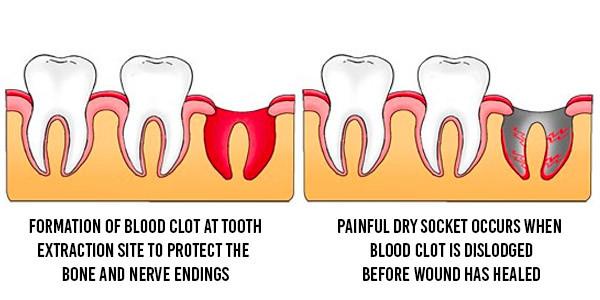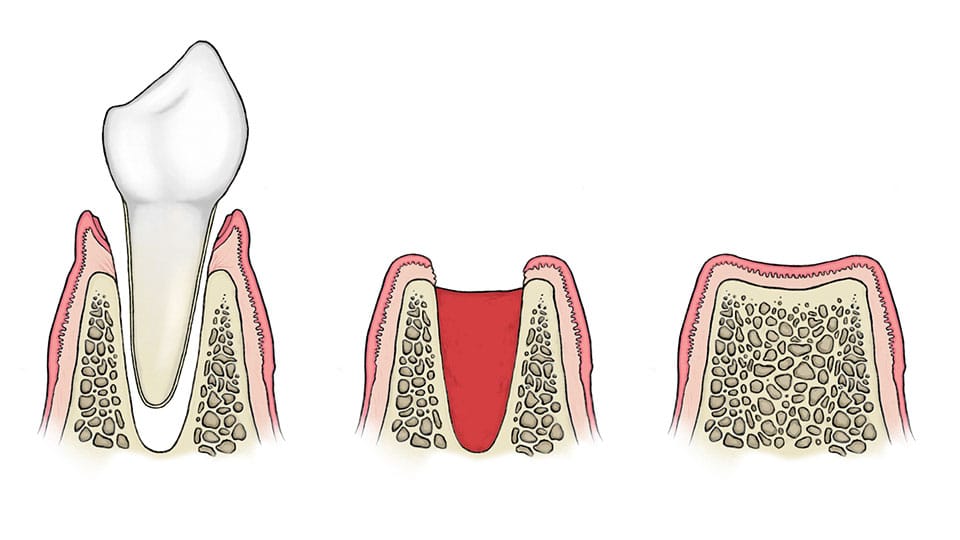We are fortunate to live in the 21st century. We now have the capabilities for adult teeth to last an entire lifetime. Only a few decades ago, a tooth lasting a lifetime was not the norm. In fact, before the 1960s, it wasn’t even possible.
Despite the advances we currently have; unfortunately, there are some situations when a tooth cannot be saved. The best option for those circumstances is for the tooth to be extracted. If this is you, it is unfortunate, but don’t get discouraged. The site will heal and will typically be able to receive a dental implant or a bridge to restore the area, unless it’s a wisdom tooth.
When a tooth is extracted, the tooth that is removed leaves a temporary space in its place. During healing the hole is usually what people find most noticeable.
You will need to keep the area clean, take pain medication to manage discomfort, and avoid allowing food to trap in the site. With these routines in place, you are probably wondering, how long does it take the hole to close after tooth extraction? In this article, we will talk about types of tooth extractions, healing after extractions, and how long it will take the hole to close.
And if you’re wondering how long it takes the hole to close after a tooth extraction, you probably should also know all the tips and tricks for how to prevent issues. For the do’s and don’ts after tooth extraction, check out this article.
Do Some Teeth Heal Differently After a Tooth Extraction?
Did you know that, depending on the tooth, an extraction can heal differently? There are a few reasons for that.
The first is the location of the tooth extraction in the mouth. Generally, the top teeth heal faster compared to the lower teeth. The bottom bone is denser than the top bone. Because the lower jaw has more dense bone, it takes longer to replace the empty site with bone.
The second effect on healing is based on the orientation of the gums. This one is a bit counter-intuitive. I want you to think about how much space the tooth takes up in the gums. Teeth that have not erupted yet, like unerupted wisdom teeth or teeth broken under the gumline, generally heal faster. Here’s the reason why: the gums are closer together from the start, like two pieces of fabric that match up perfectly. After the tooth is removed the gums suture nicely together, covering more of the hole. However, when a tooth is large and erupted, the gums have to grow to cover the hole where the tooth was.
The third effect on healing is the type of extraction. There are two types of tooth extractions. I want you to think of these in terms of the analogy of delivering a baby. A baby can be delivered naturally when it is positioned to slide through the birth canal. However, when positioned with insufficient space, a cesarian incision is required to create space for the baby to safely pass through. The same goes for teeth extractions.
There are two primary types of tooth extractions:
- Simple Extraction – The tooth is positioned in a way that it may be loosened and pass from the socket without surgically creating space around the tooth.
- Surgical Extraction – The tooth is positioned in a way that there is a lack of leverage to engage the tooth, or there is insufficient space for it to pass through. The dentist or oral surgeon creates space around the tooth by using a handpiece to reshape the bone so the tooth has room to pass through. Think of this as the tooth equivalent of a c-section, except it only involves the localized area around the tooth.
The fourth component that affects how a tooth extraction heals is the medical history of the patient. This one only applies to particular medical conditions. Some medical conditions that can slow the healing of a dental extraction are diabetes, autoimmune diseases, and immunosuppression.
So How Long Does it Take the Hole to Close after a Tooth Extraction?
The amount of time required for a tooth extraction hole to heal depends on several factors–the location in the mouth, the positioning of the tooth, and the difficulty of extraction.
In general, you can expect a tooth extraction to be 85% healed at 2 weeks, 90% healed at one mouth, and the final healing takes place over the following 3-6 months. The hole for a tooth extraction generally will begin to close around week 3 postoperatively and will be fully closed by week 4 to 6.
A few weeks after a tooth extraction, many people are pain free, but become concerned that they still have a hole in the place of the tooth. They wonder if the hole will remain forever, and I am glad to tell you, the site will heal. I know it feels like forever, but the hole will slowly close, and the site will fill in. Give it time, about 4 to 6 weeks to be exact, and if it’s still not closed at that point, you should followup with your dentist to discuss.
Top Tips to Decrease Healing Time After a Tooth Extraction:
- Eat nutritious meals even though you may not feel like it – focus on soft foods for the first 4-5 days, and then slowly introduce more foods. If your interested, check out some creative soft food ideas after a tooth extraction.
- Stay Hydrated
- Do not use straws or vigorous rining, this may dislodge the blood clot and cause a try socket. We’ll discuss more on that later.
- Brush your teeth, but do not brush the site where the tooth was extracted.
- Do Not Smoke. It’s another common cause of dry sockets.
- Warm salt water gentle rinses four times per day starting 24 hours following surgery, but limit them to a 3-4 times a day.
- If your site is feeling better but then has an increase in pain or swelling, contact your dentist or oral surgeon. This is a common symptom of getting food caught in the extraction hole, or symptoms of a dry socket.
TMJ Pain After a Tooth Extraction
A limited range of mouth opening, also called trismus, is typical for about a couple weeks after a tooth extraction, especially for a lower wisdom tooth. The reason is there is normal swelling that occurs while the tooth is healing. The swelling can temporarily limit the space for the TMJ (Temporomandibular Joint).
To help reduce swelling from a tooth extraction anti-inflammatory medications like Ibuprofen usually help. If you have TMJ soreness or limited opening that lasts longer than two weeks contact your dentist or oral surgeon to check in with them.
What is Dry Socket? The enemy of the Hole to Closing after a Tooth Extraction
Dry socket is a condition that occurs following tooth removal. The technical term we call a dry socket is called alveolar osteitus. If you see that term about tooth extractions, it means the same.
So here’s the deal with how dry sockets work. After a tooth extraction, a blood clot forms over the top of the extraction site to protect it during healing. Sometimes, before the socket heals, the blood clot is dislodged. An extraction site, without a blood clot, temporally disrupts healing. It exposes the sensitive gum and bone tissue to air, foods, and foreign objects, which can lead to pain or sensitivity. It also makes the site prone to infection.
People who use tobacco, drink carbonated beverages, chew using the treated area too soon, brush the treatment area, and those who take certain medications are at increased risk for dry socket following tooth removal.
How Will I Know I Have Dry Socket?

When a tooth is removed, there is a space left where the tooth was. The remaining hole is only temporary. A dry socket has to do with the temporary hole left, specifically with how it is healing.
A dry socket is a common complication that can happen after a tooth extraction. When the blood clot is lost too early before the hole can close, thats a dry socket. When it happens the healing slows and the site feels painful, sensitive, and sometimes swells. Let’s talk about the common symptoms that occur with a dry socket:
- Throbbing pain around the extraction site
- Pain that radiates to the ear or jaw
- Bad breath and a foul taste in the mouth
- The site looks inflamed and has a visible hole
- Gray discoloration and swelling around the outside of the extraction site
How is Dry Socket Treated?
A dry socket is relatively common. Approximately 3% of tooth extractions develop a dry socket, and as many as 30% of wisdom teeth extractions develop a dry socket. If it happens to you, it’s unfortunate, but do not be alarmed. The treatments for dry sockets are routine and effective.
Many patients with dry socket choose to manage their symptoms at home. In most cases, a dry socket will heal on its own. The site just heals slower for a few days while it recovers. If the discomfort from a dry socket is moderate or severe, you should contact your dentist or oral surgeon for a followup.
The dentist will usually numb the area, clean out the dry socket, and allow the blood clot to reform, essentially restarting the healing for you. The dentist may also prescribe anti-inflammatory medication, pain relievers, and/or antibiotics to help you during your healing.
Wrap Up: How Long Does it Take the Hole to Close after Tooth Extraction
The healing of a tooth extraction is, fortunately, a controllable process. By following the tips in this article, it will help you to heal fast and uneventfully.
As with most things, prevention is the best method. You came here wondering, how long does it take the hole to close after a tooth extraction, and now you picked up additional recommendations to guide healing. You are one step ahead in helping your body to recover successfully. Bravo!


